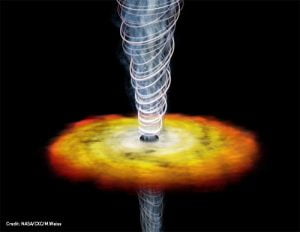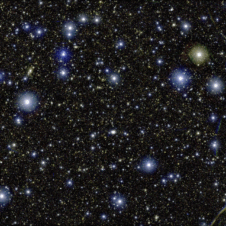
An artist’s impression of a quasar
ICRAR researcher Dr Hayley Bignall has received a Young Scientist Award to attend the 2010 Asia-Pacific Radio Science Conference to be held in September in Toyama, Japan.
The international Young Scientist Award is for researchers under the age of 35 in the field of radio science, and assists winners to present to colleagues from around the world at the conference.
Dr Bignall will be summarizing recent results on twinkling radio signals from quasars at the meeting, which will be her first general radio science conference.
“I’m looking forward to being able to meet researchers from other fields within radio science, and talk with them about current developments in quasar radio astronomy,” says Dr Bignall.
Quasars are a type of galaxy that shine very brightly in the radio spectrum. The most compact quasars twinkle when we look at them with a radio telescope, not unlike how a star twinkles when we look at it from the Earth.
In the case of stars, the twinkling is caused by the Earth’s atmosphere. Similarly, the twinkling of quasars is caused by what can be considered the atmosphere of our galaxy – the interstellar medium, the ‘stuff’ between the stars.
Signals from quasars are scattered in the gas between the stars in the Milky Way, causing the signal from the quasar to change rapidly when we view it from Earth. The scattering, and therefore twinkling, occurs because the interstellar medium is not uniform, it has small differences in density throughout.
Astronomers have figured out a way to use this twinkling to their advantage, to observe the quasars in greater detail than even the world’s largest radio telescopes could manage.
Dr Bignall will be describing the unique challenges and opportunities presented by observing quasars in this way to a field of colleagues from all the radio sciences.

